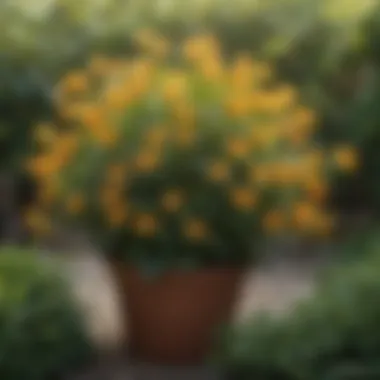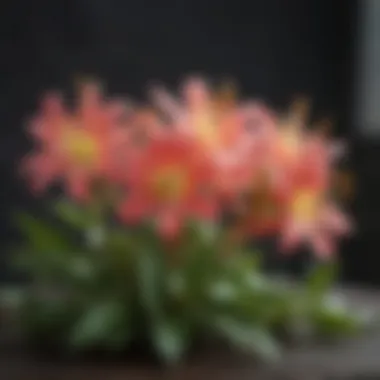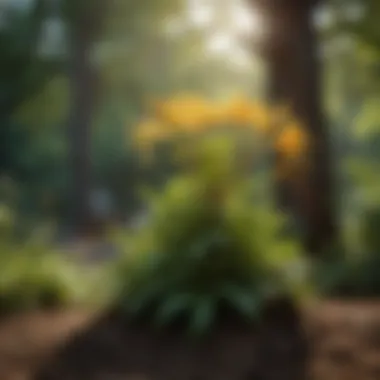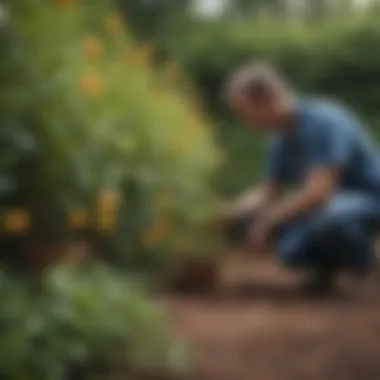Understanding the Cost and Value of Honeysuckle Plants


Intro
Honeysuckle plants are cherished for their fragrance, vibrant colors, and ability to attract pollinators. However, understanding the cost and value of these plants requires more than just a glance at price tags. This article will discuss the factors affecting the price of honeysuckle, the various types available, regional pricing differences, and their contributions to landscaping. Additionally, we shall explore care costs and the potential return on investment for homeowners and gardening enthusiasts.
Taking into account the many aspects of honeysuckle plants helps in making informed choices. Those who seek to plant honeysuckles should consider the long-term benefits rather than focusing solely on initial expenditure. This detailed examination serves to illuminate the broader significance of honeysuckle plants in residential gardens and professional landscaping projects.
Given the intricate layers of cost and value linked with honeysuckle plants, we will delve into the details methodically, ensuring a clear understanding for all readers.
Prologue to Honeysuckle Plants
Honeysuckle plants are more than just decorative elements in gardens. They offer numerous benefits, from enhancing the visual appeal of landscapes to attracting wildlife. In this section, we will explore essential aspects of honeysuckle plants. By understanding these elements, homeowners can make informed choices about incorporating them into their spaces.
Defining Honeysuckle
Honeysuckle belongs to the Caprifoliaceae family, comprising around 180 species. These plants are known for their fragrant flowers that can bloom from spring to fall. The variety of honeysuckle ranges from shrubs to climbing vines, making them versatile for different gardening needs.
Most honeysuckle plants thrive in well-drained soil and plenty of sunlight. This adaptability allows them to fit into various ecosystems and gardening styles. Their sweet nectar and colorful flowers also attract pollinators, making them valuable for anyone looking to support local flora and fauna.
Common Varieties of Honeysuckle
When considering honeysuckle, several common varieties stand out:
- Japanese Honeysuckle: A vigorous vine known for its fragrant, tubular flowers. It tends to bloom throughout the summer.
- Trumpet Honeysuckle: This variety features trumpet-shaped flowers that attract hummingbirds. It grows best in USDA zones 4 to 9.
- Amur Honeysuckle: Mostly a shrub, it boasts small flowers followed by bright berries. It is perfect for growing in hedges or as a background plant.
Choosing the right variety depends on the intended use—whether to fill space, provide shade, or attract wildlife. Each type carries its unique characteristics, offering different benefits and maintenance needs.
Factors Influencing the Cost of Honeysuckle Plants
Understanding the cost associated with honeysuckle plants is essential for those looking to enhance their gardens or landscapes. This section delves into various aspects that affect pricing, providing insights that help homeowners make informed decisions. Factors such as species and variety, size and maturity, as well as propagation methods will be discussed in detail. Each element contributes to not only the costs but also the perceived value of the plants in a garden setting.
Species and Variety
Honeysuckle plants come in a multitude of species and varieties, each offering distinct characteristics and benefits. The specific type influences the market price significantly. For example, varieties like Lonicera japonica, known as Japanese honeysuckle, may come with a different price tag compared to Lonicera sempervirens, the native trumpet honeysuckle. Typically, more common varieties might be less expensive because they are readily available.
Collectors and enthusiasts often seek rarer species, which can command higher prices due to their uniqueness and lower availability. When choosing a species, consider what fits best within your local ecosystem, as well as your aesthetic preferences. The balance between affordability and the desired characteristics plays a vital role in decision-making.
Size and Maturity
The size and maturity of honeysuckle plants can drastically change their cost. Young, small plants are usually priced lower than fully developed specimens. A young honeysuckle may cost less, but it requires time and care to establish itself in the garden. Mature plants can offer immediate aesthetics and fill space in landscaping but come with higher price points.
Homeowners must evaluate their needs carefully. If you’re looking for instant impact in your garden, investing in larger, mature plants might be worthwhile. However, if patience is possible, starting with smaller plants can be more economical and equally rewarding as they grow and fill out over time.
Propagation Method
Propagation methods significantly affect the cost of honeysuckle plants. Common methods include seeds, cuttings, or container growth. Plants propagated through seeds typically come at a lower price, as they require less initial investment. On the other hand, honeysuckles grown from cuttings or those in pots will often be more expensive due to the increased labor and care involved in their growth.


Purchasing honeysuckle plants from nurseries may include additional costs compared to growing from cuttings at home. However, investing in quality plants may reduce future risks of disease or poor growth, ultimately impacting the long-term value of your investment. Consider your own abilities and resources when deciding on the best propagation method to match your budget and gardening aims.
Regional Price Variations
Understanding the regional price variations of honeysuckle plants is essential for any potential buyer. Prices can fluctuate based on location due to factors like climate, local demand, and availability of certain species and varieties. Additionally, the economic conditions of different regions can influence overall pricing. For homeowners and gardening enthusiasts, recognizing these variations can help in making informed purchasing decisions and ultimately lead to better landscaping results.
Northeast United States Pricing
In the Northeast United States, honeysuckle plants tend to command a moderate price range. This is partly due to the climate, which supports a variety of honeysuckle species. The sellin price usually fluctuates between fifteen to fifty dollars per plant, depending on species and maturity.
Popular varieties here include the Japanese honeysuckle and the Tartarian honeysuckle. Many local nurseries focus on native plants as well. Shipping costs can affect prices too, especially for online purchases, as many nurseries must source plants from other areas. Local gardening events often provide opportunities to buy honeysuckle at reduced prices, which benefits both new and experienced gardeners.
Southeast United States Pricing
The Southeast has a unique market for honeysuckle plants. It is characterized by a diverse climate that supports the growth of various honeysuckle species. Prices in this region can vary significantly, generally ranging from ten to seventy dollars, with some specialty varieties costing even more.
Here, the scarlet honeysuckle is very popular. Home improvement stores tend to offer competitive pricing. However, the presence of invasive species legislation is limiting the sale of some non-native varieties, affecting the market landscape overall. Local gardening groups often share information about where to find the best deals, enhancing the community's knowledge about sustainable gardening practices.
West Coast Trends
On the West Coast, honeysuckle pricing exhibits interesting trends. Prices generally range from twenty to eighty dollars, influenced by both the high demand for ornamental plants and the importance of sustainable landscaping practices in this region. Golden honeysuckle and winter honeysuckle are popular choices due to their adaptability to various climates.
Offering availability is crucial here too. Some online platforms report that growers face challenges with supply variability because of changing climate conditions. Specialty gardening shows also provide a venue for purchasing unique varieties that may not be readily available at local retailers.
In summary, being aware of these regional price differences can save both time and money for homeowners and gardening enthusiasts. A strategic approach to purchasing honeysuckle plants can lead to not only savings but also thriving gardens.
Where to Buy Honeysuckle Plants
Finding the right place to purchase honeysuckle plants is essential for any homeowner or gardener looking to enhance their outdoor space. The source of your plants can significantly influence their health and overall growth potential. By considering where to buy honeysuckle plants, you not only ensure quality but may also discover unique varieties that local or online retailers offer. In this section, we will explore three primary purchasing options: local nurseries and garden centers, online retailers, and specialty plant shows.
Local Nurseries and Garden Centers
Local nurseries and garden centers provide a tangible shopping experience. This allows customers to observe the plants before buying. These establishments often carry a wide selection of honeysuckle species suited for your local climate. In addition to aesthetics, the staff at these centers are knowledgeable and can provide guidance on the best practices for planting and care.
Visiting a local nursery helps in understanding the specific needs of your regional environment. They may even offer native varieties of honeysuckle that are more resilient and beneficial for the local ecosystem. Additionally, support local businesses by purchasing through them, thus contributing to your community.
Online Retailers
Online retailers offer significant convenience, allowing homeowners and gardening enthusiasts to explore a wide range of honeysuckle options from the comfort of their home. Websites often feature extensive product descriptions, care instructions, and customer reviews, aiding informed purchasing decisions. It is also possible to access rare or specialized honeysuckle varieties that might not be available locally.
However, there are some considerations. Shipping can take time and impact plant health if not done properly. Always check the return policies and ensure that the retailer has a good reputation.
Specialty Plant Shows
Specialty plant shows gather diverse vendors, including local growers and specialty nurseries. These events are fantastic for finding unique honeysuckle plants and learning something new. Attendees can often ask experts about specific plants, gain insights into local gardening trends, and sometimes even buy plants at lower prices.
Engaging with other enthusiasts can also foster an appreciation for honeysuckle's diversity. Plant shows generally occur at specific times of the year, so checking local listings can help you plan your visit accordingly.


Caring for Honeysuckle Plants
Caring for honeysuckle plants is vital for ensuring their health and longevity. Proper care can maximize the aesthetic and environmental benefits these plants bring. It is essential to understand the specific needs of your honeysuckle variety, helping to prevent issues related to growth and maintenance. This section will cover the critical aspects of care, including soil requirements, watering needs, and pruning practices.
Soil Requirements
Honeysuckle plants thrive best in well-draining soil rich in organic matter. A pH level between 6.0 and 7.5 is generally optimal for most varieties. If your soil is heavy clay, consider amending it with peat moss or compost to improve drainage. Conversely, sandy soils should be enriched to retain moisture. Proper soil conditions help promote root health, which is essential for nutrient uptake.
Creating a good base involves:
- Testing the soil for pH and nutrients.
- Adding organic fertilizers to support growth.
- Ensuring the soil structure allows rainwater to drain.
Good soil leads to healthy honeysuckle plants which can flourish beautifully.
Watering Needs
Water is crucial for honeysuckle, especially during their initial establishment. The plants need consistent moisture, particularly in hot weather. However, overwatering can lead to root rot. A general rule is to water them deeply once a week, or more frequently in extreme heat. Monitoring your plants will help determine their exact needs, as some environments will require more attention.
Key points for watering include:
- Check the soil moisture with your fingers. If it feels dry an inch down, it’s time to water.
- Water at the base of the plant to avoid wetting the leaves, which helps prevent fungal issues.
Pruning and Maintenance
Regular pruning helps honeysuckle plants maintain their shape and encourages new growth. Pruning should be done in late winter or early spring before new buds appear. Remove any dead or damaged branches to improve air circulation. This practice can also help control size and keep your honeysuckle from becoming overgrown.
For effective pruning:
- Use clean, sharp tools to make cuts.
- Cut back roughly one-third of the plant’s growth each year, if needed.
- Consider the overall shape and desired size when pruning.
Maintaining a routine care approach ensures your honeysuckle will remain vibrant and contribute positively to your landscape.
Benefits of Planting Honeysuckle
Planting honeysuckle offers a variety of benefits, making it a popular choice among gardeners and homeowners. This section will explore its aesthetic value, environmental contributions, and its ability to attract wildlife. Each of these elements showcases why this plant type is worth considering for your landscaping needs.
Aesthetic Value in Landscaping
Honeysuckle plants are known for their vibrant and fragrant blooms. They add color and texture to garden layouts, enhancing the overall visual appeal of any outdoor space. Their climbing varieties can be used to cover trellises, arches, and fences, transforming ordinary structures into beautiful focal points. When chosen wisely, they can create stunning contrasts when combined with other floral species.
Beyond just visuals, honeysuckle's fragrance can create a sensory experience in the garden. Many homeowners appreciate the way the scent fills the air, particularly in the evening hours when people are often outside socializing or relaxing. Planting honeysuckle can effectively elevate the look and feel of a yard, offering an inviting atmosphere for family and friends.
Environmental Contributions
From an environmental perspective, honeysuckle planting plays an essential role in promoting biodiversity. These plants can help stabilize soil, reducing erosion and contributing to a healthier ecosystem. Additionally, their deep roots enhance soil health by promoting better water retention.


Honeysuckle's ability to thrive in various climates also makes it suitable for a range of regions. They can tolerate poor soils, reducing the need for chemical enhancements. This is beneficial for sustainable gardening practices. By incorporating honeysuckle into your landscape, you help improve local soil conditions while minimizing the ecological footprint of your gardening efforts.
Wildlife Attraction
Another significant benefit of honeysuckle plants is their attraction to wildlife. They serve as a food source for a variety of birds, butterflies, and other beneficial insects. The nectar-rich flowers draw in pollinators, which are crucial for maintaining plant health and diversity. This supports overall ecosystem health, fostering a balanced environment.
Furthermore, honeysuckle can provide shelter for these creatures. Dense foliage offers protection from predators and harsh weather conditions, creating a safe habitat. As a result, planting honeysuckle can turn your garden into a sanctuary for local wildlife, promoting a harmonious balance between urban living and nature.
Overall, honeysuckle plants deliver both aesthetic and practical value, making them a sound investment for those looking to elevate their landscape. Whether for beauty or environmental benefit, they certainly enrich outdoor spaces.
Potential Issues with Honeysuckle
Honeysuckle plants are celebrated for their aesthetic appeal and environmental benefits. However, potential issues exist that warrant consideration before planting. Understanding these concerns helps homeowners and gardening enthusiasts make informed decisions about introducing honeysuckle into their spaces. This section will delve into two primary issues related to honeysuckle: invasive species concerns and common pest problems.
Invasive Species Concerns
Honeysuckle is often categorized within invasive species discussions due to its vigorous growth and tendency to spread rapidly in various environments. Non-native varieties, such as Lonicera japonica and Lonicera maackii, can dominate local ecosystems, displacing native plants and altering habitats. This behavior can lead to reduced biodiversity and disrupt local flora and fauna.
Key considerations include:
- Growth patterns: Some varieties can grow extensively, leading to thick thickets that overshadow other plants, compromising their health.
- Local environment: In certain regions, these invasive honeysuckles can proliferate places like forests and fields, significantly impacting the native ecosystem.
- Compliance with local regulations: Some areas regulate or ban the sale of particular invasive honeysuckle species. It is crucial to be aware of local guidelines before purchasing or planting.
To mitigate some of these issues, gardeners should consider opting for native honeysuckle varieties, which generally pose less risk to local ecosystems while still providing beauty and habitat for wildlife.
Pest Problems
While honeysuckle is generally easy to care for, it is not immune to pest issues. Various insects can inflict damage, potentially undermining the health of the plant and limiting its overall enjoyment. Common pests include aphids, spider mites, and Japanese beetles. Each of these pests can affect honeysuckle differently, impacting both foliage and blooms.
Common pest impacts:
- Aphids: These small insects suck sap, which can lead to yellowing leaves and stunted growth. Their presence may also attract ants, which protect them from their natural predators.
- Spider Mites: These tiny pests thrive in dry conditions, causing fine webbing and leaf yellowing. Regular watering and humidity can help control their population.
- Japanese Beetles: Known for their voracious appetite, they can skeletonize leaves, significantly decreasing the plant's vigor. Handpicking these pests or introducing natural predators can help manage their numbers.
Regular monitoring is essential to identify and address these pest issues promptly. Proper plant care and responsive treatments can maintain the vitality of honeysuckle plants and ensure they thrive without significant hindrance from pest pressures.
Understanding potential issues associated with honeysuckle plants is essential for sustainable gardening practices. Taking proactive steps can help integrate them beneficially into your landscape, providing beauty while respecting local ecosystems.
Closure: Evaluating the Investment in Honeysuckle Plants
Making a decision about planting honeysuckle requires more than just an appreciation for its beauty. This conclusion ties together the various elements we've explored about honeysuckle plants, focusing on cost, benefit analysis, and long-term value. Whether for aesthetic appeal or ecological advantage, understanding the investment of time and resources can help guide homeowners and gardening enthusiasts toward making informed choices.
Long-Term Value Assessment
The investment in honeysuckle plants is one deeply intertwined with their long-term benefits. At first glance, the initial cost may seem high for some species or established plants. However, it's essential to consider the longevity and benefits that honeysuckle provides. Mature plants often require less maintenance and offer substantial natural beauty to gardens. In many cases, honeysuckles can last several years and even become a remarkable focal point in landscape design.
Moreover, some varieties of honeysuckle contribute to the ecosystem by attracting pollinators like bees and butterflies. This interaction not only supports local biodiversity but also enhances the growth of other plants in the vicinity. This relationship can lead to better soil health and overall garden performance, which is crucial for those looking to optimize their outdoor spaces.
Factors like the adaptability of specific honeysuckle species to various soil types and climate conditions further cement their role as a worthwhile investment. Homeowners should account for these elements when deciding on their landscaping strategies. Over time, the benefits can often outweigh the initial costs, leading to a thriving and sustainable garden.
Final Thoughts
As with any gardening endeavor, it is crucial to approach the decision holistically. Take into account not only the purchase price but also ongoing care, maintenance, and the overall impact on your garden’s ecosystem. With careful planning and consideration, planting honeysuckle can indeed prove to be a valuable investment for both current enjoyment and future ecological benefits.
"Choosing the right plants is not merely about aesthetics but understanding their role in our environment."















